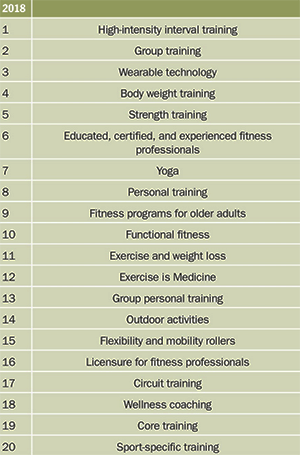 In the American College of Sports Medicine’s annual worldwide survey of current fitness trends (the 2018 edition), they ranked high-intensity interval training (HIIT) at the very top as per the image/list from the article to the right.
In the American College of Sports Medicine’s annual worldwide survey of current fitness trends (the 2018 edition), they ranked high-intensity interval training (HIIT) at the very top as per the image/list from the article to the right.
That’s of course no surprise to many, though it seems I run into people just about every day who aren’t sure what to think about HIIT, presume that it’s too extreme for those of us over 40, particularly if we’re significantly deconditioned and/or overweight. There’s another cadre of HIIT skeptics who fall into the “chronic cardio lifer” category.
Yet the pull of HIIT is inescapable.
HIIT offers for most identical – or greater – fitness benefits compared to much longer, historically traditional cardio-focused workouts. High-intensity interval training can be completed much more quickly, is damned efficient at producing its benefits, induces less physical (and quite possible biomechanical stress, pending your workout choices) stresses on your system, saves joint wear and tear, and provides a great change-up in your routine.
A Quick Glance at HIIT in the Literature
I know, I know, almost everybody you read these days reaches back to one of the first (landmark) studies published looking at HIIT vs moderate-intensity cardio – the 1996 study in Medicine and Science in Sports and Exercise. HIIT completed five days per week was clearly more effective than traditional cardio in measures of both aerobic and anaerobic fitness; of note, the workout program in the study was eventually described as the Tabata protocol (20 second sprints, 10 second rests, 7-8 reps).
But wait, five days of HIIT per week? This study from the International Journal of Obesity in 2008 showed impressive benefits from only three times per week HIIT over 15 weeks, with body changes impressively better than the moderate-intensity cardio group.
This study from 2007 showed low-volume HIIT (sprint training) physiologic improvements were basically the same as (for the day) typical endurance training regimens. Another study from 2006 again demonstrated similar benefits in a low-volume sprint group compared to a high-volume endurance group in exercise tolerance/capacity and a detailed skeletal muscle analysis.
And despite chronic cardio’s dominant position for decades as the purported cornerstone of improving cardiac function and health, this study (2008) clearly demonstrated that HIIT was as effective as traditional endurance training in measures of arterial stiffness and flow-mediated arterial dilation. Even my own specialty (Physical Medicine and Rehabilitation) has recently published a study on HIIT in cardiac patients, with a good review of workout intensity recommendations as well.
A Few Quick Thoughts on Starting Your Own HIIT Program
Without a doubt those with significant cardiopulmonary disease such ischemic or other heart disease, valvular disease, history of MI (heart attack), or cerebrovascular disease (stroke) should clear a HIIT program with their physician. For that matter, if you have any major medical or orthopaedic issue (T2 or T1 diabetes, hypertension, any arthropathy whether it’s degenerative/osteoarthritis, gout, or others, or perhaps osteoporosis), it’s worth clearing HIIT with your doc.
Don’t forget that you can accomplish a very effective HIIT workout with lower-impact exercise; the HIIT game is all about intensity, briefly pushing to 85 (up to 100) percent of your age-adjusted maximal target heart rate with short bursts of more intense effort, combined with/alternating with brief (yet still moving) recovery periods.
For the more mature among us, I often suggest starting with common-sense, fairly simple, whole-body/at least multi-joint movements/exercise for your HIIT program. Think of simple stuff like swimming, walking lunges, walking up an incline/hill, hill jogging/running, simple sprints (i.e., running, stationary bike, elliptical). Even squats, pushups, or jumping jacks will work.
Start slowly, listen to your body, and don’t push for more than one HIIT workout per week or even every ten days to start. You may need to experiment with several different specific workout versions to find what fits your capacity, tolerance, current level of overall fitness, and interests today (remember, this is supposed to be fun).
More on HIIT to come shortly.



Leave a Reply